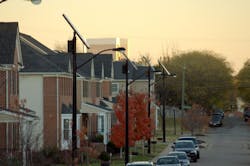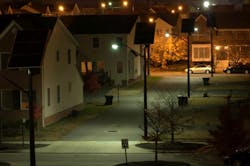The potential savings in eliminating the need for trenching and wiring conventional street lights led Premier homes to turn to solar SSL products from Sol Inc. for the new Randolph West residential neighborhood.
Generally, most people think of solar power as a renewable green energy source and in some cases a way to save money relative to gird power, but increasingly the total cost of ownership of solar guides deployment decisions in outdoor lighting applications. Premiere Homes LLC (PHL), based in Richmond, VA, tapped Sol Inc. to install solar-powered LED street lights based primarily on lower upfront installation costs and secondarily on the long-term energy savings.
Indeed, in new construction, the cost of connecting outdoor solid-state lighting (SSL) to the AC grid can be significant. We covered a number of examples including LED trail lighting in Massachusetts and street lighting in Abu Dhabi in a feature article on presentations made at the February Strategies in Light conference.
Looking back, solar has not been the best match for street lighting because of the high light levels required for safety and the long operating hours. Solar panels, with efficiency just over 10%, couldn't power legacy light sources without excessively large panels and expensive batteries. The efficiency of LED sources and improving battery technology, however, has made solar a viable option — especially in new construction projects where the cost of connecting to the grid is an issue.
Just such a situation arose at the PHL Randolph West community of 70 new single-family homes. "As we were developing the infrastructure for Randolph West, it soon became clear that grid-tied street lighting would be much less efficient and would add significant time to the project," said Sean Bowers, chief operating officer at PHL. "Once we began to value-engineer possible options, we quickly identified Sol's commercial solar outdoor lighting as the ideal solution."
Indeed, the Richmond builder avoided the cost of trenching, wire installation, and electrical infrastructure connections that are commonplace in roadway lighting projects. Meanwhile, the city suffered lesser impacts to traffic and parking in the neighborhood, along with less noise. In the end both the builder and the city benefited from the solar choice and the city ended up with a notable green-energy success story.
"As demonstrated by the Randolph West project, solar-powered outdoor street lighting brings significant value to our community and helps us meet our sustainability, social, and economic goals," said Christopher Beschler, chief administrative officer of operations for Richmond. "For this project, solar lighting was far more effective than traditional grid-tied street lighting, enabling us to provide our residents with visible proof of our city's commitment to sustainability."
The solar option is still a new one to most specifiers working on street-light projects where the lights must illuminate reliably. Solar is regularly used in area lighting projects that have a slightly lesser requirement in terms of the lights working all night every night. But the combination of better power electronics, more-efficient panels, LED sources, and battery technology are changing the landscape.
"There is no doubt that commercial solar outdoor lighting is now a cost-effective and high-quality alternative to traditional grid-tied outdoor lighting," said Dibs Tailor, CEO of Sol. "As demonstrated by the public acclaim garnered by the Randolph West project, our commercial solar outdoor lighting systems provide significant economic benefits to budget-constrained municipal governments, while also contributing to a reduction in greenhouse gas emissions that mitigate the negative effects of global warming."







